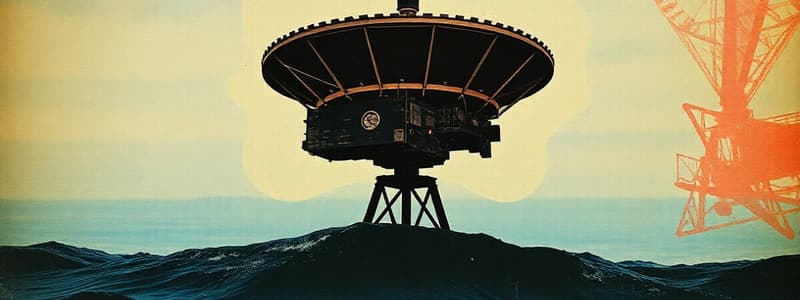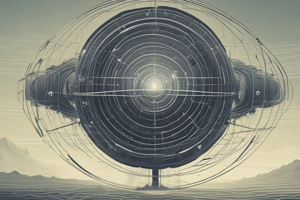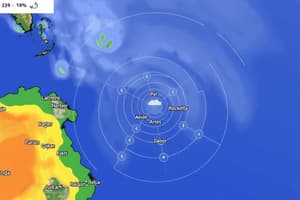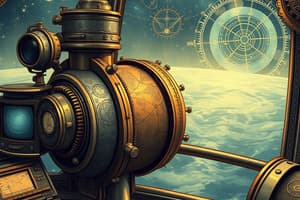Podcast
Questions and Answers
What type of waves does radar primarily use?
What type of waves does radar primarily use?
- Gravitational waves
- Electromagnetic waves (correct)
- Seismic waves
- Acoustic waves
What does SOFAR stand for?
What does SOFAR stand for?
- Sound Fixing and Ranging (correct)
- Sonic Observation and Frequency Analysis Record
- Surface Ocean Finding and Retrieval
- Submarine Observation and Ranging
In what decade did the development of modern sonar begin?
In what decade did the development of modern sonar begin?
- 1940s
- 1910s
- 1920s (correct)
- 1930s
Which country's U-boat threat spurred rapid sonar development?
Which country's U-boat threat spurred rapid sonar development?
In what year did the USS New York have the first permanently installed U.S. radar?
In what year did the USS New York have the first permanently installed U.S. radar?
What does radar determine about a target?
What does radar determine about a target?
Which committee recommended the development of nuclear-powered submarines?
Which committee recommended the development of nuclear-powered submarines?
Which Naval Research Laboratory development was reported in 1949?
Which Naval Research Laboratory development was reported in 1949?
What is one reason why low-frequency sounds are important in sonar technology?
What is one reason why low-frequency sounds are important in sonar technology?
Which of these is a place where U.S. Navy World War II victories were contributed to by radar?
Which of these is a place where U.S. Navy World War II victories were contributed to by radar?
What organization did the Chief of Naval Operations direct to institute a program of research in low-frequency sonar?
What organization did the Chief of Naval Operations direct to institute a program of research in low-frequency sonar?
What phenomenon did Leo C. Young and Dr. Alfred Hoyt Taylor first observe?
What phenomenon did Leo C. Young and Dr. Alfred Hoyt Taylor first observe?
Which event prompted the U.S. Naval Research Laboratory to explore radio for ranging and detection?
Which event prompted the U.S. Naval Research Laboratory to explore radio for ranging and detection?
What was a critical factor for national survival regarding undersea warfare?
What was a critical factor for national survival regarding undersea warfare?
What provided audio information via earphones to frogmen using new sonar equipment?
What provided audio information via earphones to frogmen using new sonar equipment?
Which oceanographer and researcher pioneered studying underwater sound and established a SOFAR station in Bermuda?
Which oceanographer and researcher pioneered studying underwater sound and established a SOFAR station in Bermuda?
What type of analysis did the Hartwell Committee recommend to be used to detect submarines?
What type of analysis did the Hartwell Committee recommend to be used to detect submarines?
How was a diver-held sonar system powered?
How was a diver-held sonar system powered?
Flashcards
What is Radar?
What is Radar?
Radio Detection and Ranging. Remote sensing system that sends out electromagnetic waves.
What is Sonar?
What is Sonar?
Sound Navigation and Ranging. Remote sensing system that transmits acoustic waves.
Radar vs. Sonar Usage
Radar vs. Sonar Usage
Radar signals are primarily for surface and atmospheric observations, because electromagnetic waves diminish in the water. Sonar signals easily penetrate water.
First U.S. Radio Reflection Observations
First U.S. Radio Reflection Observations
Signup and view all the flashcards
First U.S. Radar Installation
First U.S. Radar Installation
Signup and view all the flashcards
WWII Battles Aided by Radar
WWII Battles Aided by Radar
Signup and view all the flashcards
When did modern sonar begin?
When did modern sonar begin?
Signup and view all the flashcards
World War II U-boat threat
World War II U-boat threat
Signup and view all the flashcards
SOFAR hydrophones
SOFAR hydrophones
Signup and view all the flashcards
Key Sonar Development Factors
Key Sonar Development Factors
Signup and view all the flashcards
Study Notes
- Radar (Radio Detection and Ranging) and Sonar (Sound Navigation and Ranging) are remote sensing systems that rely on wave transmissions.
Wave Transmissions in Radar and Sonar
- Radar transmits electromagnetic waves.
- Sonar transmits acoustic waves.
- Both systems use echoes from waves to determine the size, shape, distance, and speed of a target.
Applications of Radar and Sonar
- Radar signals are best suited for surface and atmospheric observations.
- Sonar signals easily penetrate water, are ideal for underwater navigation and detection.
Early Radio Reflection Observations
- Leo C. Young and Dr. Alfred Hoyt Taylor made the first U.S. observations of radio reflection.
- Scientists detected radio wave reflections from aircraft eight years after initial discovery.
Development of Radar Technology
- From 1930 to 1940, the U.S. Naval Research Laboratory researched the use of radio for ranging and detection.
- In 1935, $100,000 was provided to the Naval Research Laboratory for radar development.
- The first U.S. radar, XAF, was permanently installed on USS New York (BB-34) in 1938.
- By December 7, 1941, 20 radar units were installed on selected ships
- Radar contributed to U.S. Navy victories in World War II, specifically at the:
- Battle of the Coral Sea
- Battle of Midway
- Guadalcanal
Sonar Development
- Modern sonar development began in the 1920s with advancements in underwater sound applications.
- Ships developed depth sounding and echo ranging on submarines.
- Thomas Edison and others researched passive listening devices, while other researchers explored oceanography.
Sonar in World War II
- Sonar development accelerated during World War II due to German U-boat threats.
- German submarines rapidly torpedoed Navy-escorted convoys.
- Ships were being sunk faster than the U.S. could replace them, some near the U.S. eastern seaboard.
- Mobilization of the U.S. workforce and sonar development helped contain the U-boat threat.
Post-War Sonar Advancements
- In 1949, the Naval Research Laboratory detected submarines at 10–15 nautical miles using SOFAR hydrophones.
- Submarines could be detected several hundred miles away by the end of the year.
- Dr. Maurice Ewing established a SOFAR station in Bermuda in 1949.
- The Committee on Undersea Warfare of the National Research Council discussed a long-term program to counter the Soviet Union's submarine force.
- The Hartwell Committee was formed to conduct a broad study and considered the ability to transport people and goods crucial.
Hartwell Committee Recommendations
- Development of nuclear-powered submarines.
- Detection of submarines using real-time spectral analysis of radiated sound energy for antisubmarine warfare.
- Admiral Thorwald A. Solberg was directed to arrange a research and development program in low-frequency sonar with Bell Telephone Laboratories.
Key Factors in Sonar Development
- Discovery that low-frequency sounds travel great distances in the ocean.
- Realization that submarines radiate identifiable low-frequency energy.
- Bell Laboratories played an important role.
Studying That Suits You
Use AI to generate personalized quizzes and flashcards to suit your learning preferences.
Related Documents
Description
Explore remote sensing systems like Radar and Sonar, which use wave transmissions to determine target size, shape, distance, and speed. Radar, using electromagnetic waves, is ideal for surface and atmospheric observations, while Sonar, using acoustic waves, excels in underwater navigation and detection.




